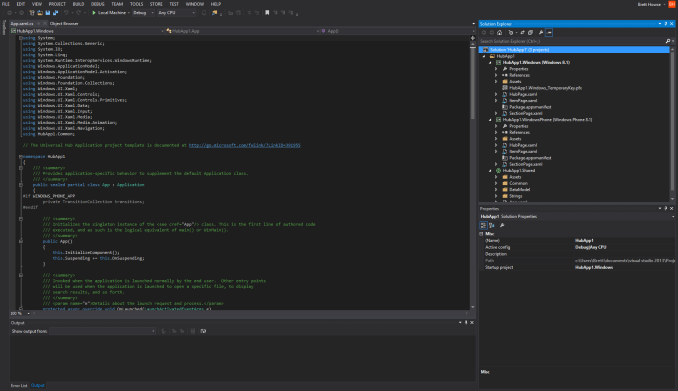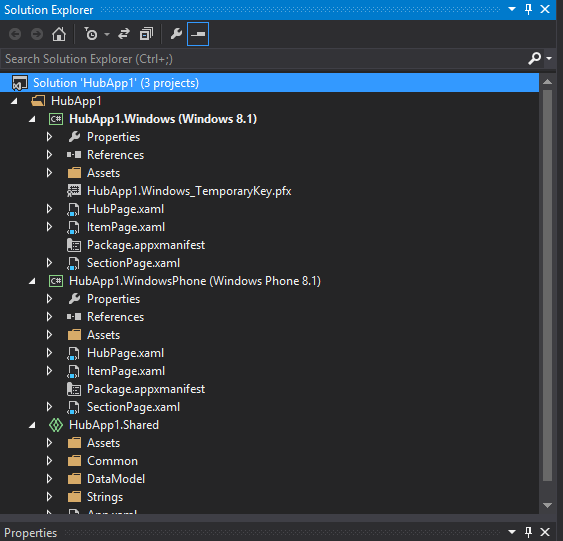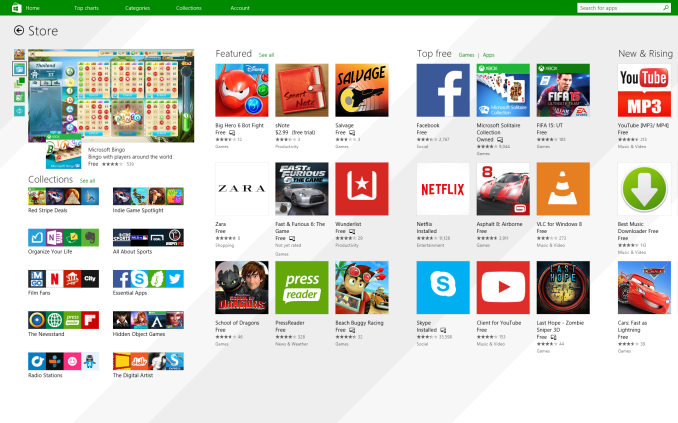Windows 10 Technical Preview First Impressions: The Return Of The Desktop
by Brett Howse on November 13, 2014 8:00 AM EST- Posted in
- Software
- Microsoft
- Windows 10
Universal Apps and the Windows Store
We just got done discussing why a single user interface for the OS across multiple devices is not always the ideal solution, so of course the obvious question with Universal Apps is why would you want it with the app model instead? Thankfully this is not the case although the term Universal App might lead people to believe they are attempting to have a single app target all of their platforms. The truth of the matter is that Universal Apps are Universal in the sense that they share a common app store.
If Microsoft is going to have Windows 10 succeed on desktops, laptops, tablets, phones, and even Xbox One, they need developer buy-in. A platform without apps is not much use to anyone. With the Universal App, they can bridge all of their platforms with a single App in the store. Under the hood, each app is created with a common framework of code, as well as multiple user interfaces in order to tailor the experience to the correct device type. Below is a screenshot of Visual Studio – Microsoft’s developer tools – with a new Universal App about to be created.
 Visual Studio Showing a Universal App Project
Visual Studio Showing a Universal App Project
As you can see, there is a shared portion of code, and then a project for the UI for Windows 8.1, and Windows Phone 8.1. Xbox One is not available yet, but should be added in a future release of Visual Studio.
A close up of the projects
But you may be wondering why any of this is necessary. Windows has the largest selection of applications of any system ever. That is of course true, and the Win32 framework has served both Windows and its users well over the years. But with the new WinRT framework there are some big advantages. First, it can be written to in multiple languages including HTML. WinRT supports C++/CX, C#, VB.NET, and HTML scripting with JavaScript and TypeScript. The security model for WinRT apps is a lot different than Win32, with all WinRT apps running in a sandbox mode for higher security. Unlike apps written in .NET, WinRT is native code, which should result in better performance. Contracts and Extensions are also new to WinRT, and allow apps to share data while still being in a sandbox. One of the biggest advantages of WinRT is that it is DPI aware, and can automatically scale apps appropriately based on screen size and screen resolution. Here, as we know, Win32 apps can struggle even though there are solutions in place.
Adobe Touch WinRT (left) vs Adobe Reader Win32 (right) on HiDPI display
One of the biggest disadvantages of WinRT is that it is only available on Windows 8 and newer devices. With Windows 8 struggling in the market as compared to Windows 7, the user reach of a developer targeting WinRT apps in the Windows Store would be for a subset of the total user base. With Windows 7 having over 50% of the desktop OS market share to itself, this is going to be an issue.
With Windows 10, Microsoft is certainly targeting Windows 7 users. If they can convince them to upgrade to the latest version of the operating system, then the new environment will have a much larger target base and will hopefully encourage developers to target the Windows Store. We have not heard of any upgrade promotions or pricing yet, but this is one of the biggest advantages Apple has had over the years. Their user base generally upgrades the OS at a much faster uptake than Windows. This allows developers to utilize newer APIs in the latest versions of their operating systems and keep the platform progressing. Microsoft has already had to deal with people being stuck on Windows XP, and they must be wanting to avoid that with Windows 7.
Since we are discussing Universal Apps and their advantages, one of the biggest advantages is the Windows Store. With Microsoft hosting the entire download and purchase of all WinRT apps, having user settings and apps sync from one device to another is much easier. One of the greatest experiences with Windows 8.1 is signing into a new PC for the first time. When you log in with your Microsoft Account, the system asks you if you would like to copy the devices and apps from one of your other devices, or if you want to start with a clean machine. If you choose a previous machine, all of the settings, wallpaper, Start Screen layout, and Windows Store apps are synced to the new device. In the case of Windows Store apps, the app itself is listed on your Start Screen, but it is not downloaded until the first time you select it. This avoids a situation where you will significantly delay the initial login time with a massive download, as well as avoid filling the available storage with apps you may not need on that particular device.
Also, like modern tablet and smartphone OSes, WinRT apps from the store are automatically kept up to date by the store. This avoids a lot of the issues with viruses and malware attacking an older version of a product since in theory it will not be around any longer.
The one thing missing from this are the older Win32 apps on the desktop, because they are not available in the Windows Store. Prior to Windows 10, desktop apps could be listed in the store, but the store would then link to the developer’s website to allow you to purchase and install the app. With Windows 10, rumors are that desktop apps will also be available and managed through the Windows Store. Assuming this does happen, then this will be a major boon to users. Desktop apps should in theory also be able to be kept up to date using the Windows Store which should cut back on the number of outdated pieces of software targeted by malware.
The Windows Store is a key piece of Windows 10. Universal Apps can be made available for multiple platforms through the store, and, if the rumors are true, even desktop apps will be available through the store. This should make the Out Of Box Experience (OOBE) very good for users with a Microsoft Account. The WinRT framework has not yet had the killer app written for it, so hopefully with Windows 10 the framework will be expanded to allow for more powerful apps to be created.













198 Comments
View All Comments
darthrevan13 - Thursday, November 13, 2014 - link
If you're referring to Windows 8.1 then all those issues where addressed (except for the calculator). If you're referring to 10 then DON'T FORGET IS A BETA. Next time you write a program and launch a beta I'm gonna say it's BS because a lot of stuff is buggy then I'll see how you like it.sphigel - Thursday, November 13, 2014 - link
Search is still god awful in Windows 8.1 Update 1. I mainly use it as an app/utility launcher and it can't even get that right. If you're running 8.1 right now give this a try. Hit the windows key and type "devices" with the intent of launching Devices and Printers. If your computer is like mine you should see Devices and Printers as the top search result. Ok, now hit enter. Did Devices and Printers launch? Nope! It launched a freaking web search for "devices"! How convenient! Hitting enter doesn't even launch the top search result!MrSpadge - Thursday, November 13, 2014 - link
It doesn't do that if you have deactivated "include web into search results", which I always do. But you're right that hitting enter upon a search doesn't launch the top item, but (without internet search) rather a full page of the search results. I can see that being useful for some. BTW: in Win 7 you'd have to hit "arrow down" once after searching to get the topmost item, right? (can't test right now)sphigel - Friday, November 14, 2014 - link
I'll have to deactivate web search because I would never use that feature. Thanks for the tip. The other problem with it not automatically selecting the top result when you hit enter is made worse by the fact that it's inconsistent. On two fully updated Win 8 computers I can search for "Control Panel" and hit enter and it will launch Control Panel. However, even if I fully type "Devices and Printers" and hit enter it will not launch Devices and Printers even though it's the top search result. I have not found any logic behind when it chooses to launch the top search result and when it chooses not to. Win7 would always launch the top search result. I would often times start typing and just continue typing until what I was looking for moved up to the top of the list and then I'd hit enter. It was much quicker and more intuitive to use search in Win7.Brett Howse - Thursday, November 13, 2014 - link
When Windows 8 came out there was talk of the desktop being deprecated completely. Clearly that's not happening now.I agree there was a lot to like with the Windows 8.1 desktop especially, but a lot of people were confused by the Touch interface on top. In Windows 8.1 though, Modern apps just are not good productivity replacements for the most part since they are full screen. Even with snap, I found they got in the way when I was trying to get work done. Having them in a window is much easier on a desktop PC.
MrSpadge - Thursday, November 13, 2014 - link
I agree that for non-touch the modern apps are mostly worse than regular programs. But they're optional, so I fail to see how not having the choice to install & use them would be any better (implying that someone wants to use this argument against 8/8.1 compared to 7 - no question 10 is doing it better).kmmatney - Thursday, November 13, 2014 - link
For non-touch, modern Apps are even worse than their web page equivalents. I've been using Windows 10 on a spare computer and it's much better than Windows 8.1. The funny thing is, it almost exactly like my Windows 8.1 computer - which I spent a lot of effort on to remove all traces of Metro.TEAMSWITCHER - Thursday, November 13, 2014 - link
My only major grip with the Windows 10 Technical Preview (aside from the bugs) is the virtual desktop implementation. Having used OS X's Mission Control, you understand the importance of animating the experience. It provides you with the context of where you are in the multiple desktop environment. Windows 10's implementation as it exists today has jarring transitions with no ability to move windows between desktops or change the rearrange the desktops. Also assigning a unique wallpaper aids in positional awareness is not possible with this implementation.OS X has set a high bar for this feature andI'm really shocked by Microsoft's "amateurish" implementation. As it exists today...the feature should be removed to avoid embarrassment. Hopefully, someone at Microsoft will listen to the feedback and take action to dramatically improve this feature.
Brett Howse - Thursday, November 13, 2014 - link
Remember this is a technical preview of pre-release software. The Multiple desktops are one of the newest features. If you want it changed, check out the Windows 10 User Voice https://windows.uservoice.com/forums/265757-window... and add a suggestion there.It seems unlikely this brand new feature will not get updated before the final release.
beggerking@yahoo.com - Friday, November 14, 2014 - link
virtual desktop is ..so 90s..now a days we have dual / tri/ quad monitor setup. works much much better.